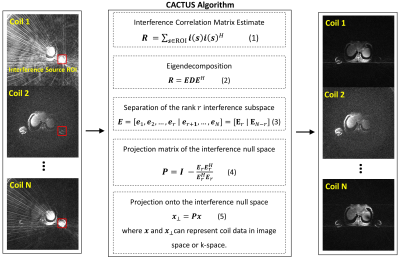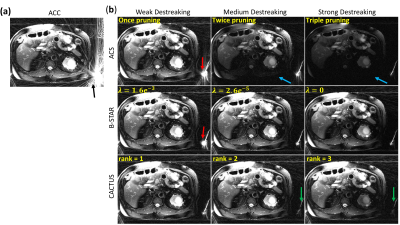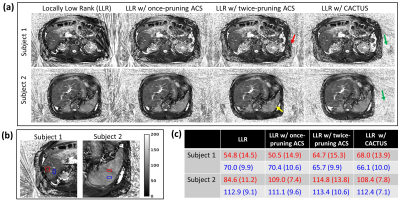0670
Cancellation of streak artifacts using the interference null space (CACTUS) for radial abdominal imaging1Department of Medical Imaging, University of Arizona, Tucson, AZ, United States, 2Department of Electrical and Computer Engineering, University of Arizona, Tucson, AZ, United States, 3Department of Biomedical Engineering, University of Arizona, Tucson, AZ, United States
Synopsis
In radial imaging, streaks due to gradient inhomogeneities can appear even when Nyquist criterion is fulfilled. Earlier techniques targeting this type of streaks remove coils contributing prominent streaks at the cost of signal loss. A phased array beamforming based technique (B-STAR), that can achieve a good trade-off between streak reduction and signal preservation, was proposed as a post-processing method. We propose CACTUS, an alternative technique for streak cancellation, which can be used either as a preprocessing method or with iterative reconstructions. In vivo abdominal experiments show enhanced image reconstructions and improved quantitative parameter maps.
Introduction
Radial trajectories are inherently robust to motion-induced artifacts$$$^1$$$ and have been shown to reduce scan times in parameter mapping.$$$^2$$$ Undersampling leads to streak artifacts in radial imaging. Even when k-space data are fully sampled, streaks can emanate from anatomical regions where $$$B_0$$$ is inhomogeneous.$$$^3$$$ Such streaks are common in abdominal imaging with large fields-of-view to accommodate larger patients and can obscure pathology. Earlier techniques$$$^{3,4}$$$ aimed to reduce these artifacts by removing coils contributing prominent streaks at the expense of signal loss. A recent technique, B-STAR,$$$^5$$$ uses phased array beamforming to remove such streaks while preserving the signal. However, B-STAR is applied to coil images as a post-processing step. Therefore, it is not suitable to be used together with iterative reconstruction techniques. Since iterative reconstructions aim to reduce streaks due to undersampling, presence of streaks due to gradient nonlinearities presents additional challenges for these techniques. In this work, we introduce a novel technique, Cancellation of streAk artifaCts using the inTerference nUll Space (CACTUS), which can be incorporated either as a preprocessing step or into iterative reconstructions.Methods
The CACTUS technique is presented in Fig.1. CACTUS aims at separating the signal and interference by identifying the interference subspace. Given the ROI(s) corresponding to the source(s) of the streaks, interference correlation matrix is estimated (Eq.1). An eigenanalysis of this matrix (Eq.2) yields eigenvectors that span the space comprising two orthogonal subspaces: interference subspace and interference null space (Eq.3). The first $$$r$$$ eigenvectors span the interference subspace and the remaining $$$N-r$$$ eigenvectors span the interference null space. The projection matrix onto the interference null space (Eq.4) can be applied either in image space or in k-space (Eq.5). However, applying the projection in k-space eliminates streaks due to gradient nonlinearities from the k-space data, which can subsequently be used with iterative reconstructions $$$\hat{m}=\arg\min_m\lVert{Em-Pd}\rVert_2^2+\lambda{R(m)} $$$, where $$$\hat{m}$$$ denotes the reconstructed image, 𝐸 denotes the encoding matrix, 𝑃 is the projection matrix obtained from CACTUS, and 𝑑 denotes the k-space data.CACTUS was evaluated using abdomen data acquired at 1.5T (Siemens, Aera) using a radial turbo spin echo pulse sequence (RADTSE$$$^6$$$) with TR=2500 ms, FA=150 deg, 192 views with 256 readout points/view, ETL=32 (to yield 6 views/TE), echo spacing=7.3 ms, slice thickness=8 mm, and FOV=40-46 cm. Streak removal was evaluated on (i) the composite images (where all radial views are used to reconstruct an image with an average TE contrast) using adaptive coil combine (ACC$$$^7$$$) and on (ii) the T2 maps reconstructed from TE data sets using a model based CS approach (LLR$$$^8$$$). For comparison, streak removal was also evaluated using auto coil selection (ACS)$$$^4$$$ and B-STAR$$$^5$$$ algorithms. Quantitative metrics based on cancellation ratio$$$^9$$$ as defined in Table 1(a) were used to compute the signal and streak cancellations.
Results
Fig.2(a) shows an example of a composite image with strong streaks emanating from the left arms (black arrow). Fig.2(b) shows the same image but after streak removal was applied using ACS, B-STAR, and CACTUS at different levels of destreaking. The strength of destreaking was tuned via different number of pruning rounds (ACS), diagonal loading weights 𝜆 (B-STAR), and the rank of interference subspace (CACTUS). The red, blue, and green arrows point to residual streaking artifacts, signal loss, and cancellation of the undesired source, respectively.Fig.3 shows two cases with mild (subject 1) and strong (subject 2) streaks, which originate from multiple sources. In subject 1, ACS results in signal drop (blue arrow) whereas CACTUS shows excellent suppression of the arms (green arrows) without noticeable signal losses in the anatomy adjacent to the arms. In subject 2, the ACS and B-STAR approaches could not fully remove the streaks from the left arm (red arrow). However, CACTUS reduced the streaks from both arms without significant signal loss.
Table 1(b) reports the quantitative performance of these methods for the three cases showed in Figs.2 and 3. It can be seen that ACS has the worst SCR suggesting an SNR decrease after coil removal. B-STAR preserves the signal better than ACS but its ICR is several decibels worse than that of CACTUS. CACTUS also achieves the best SIRG among the three methods.
Fig.4(a) illustrates the T2 maps obtained using LLR only and LLR with once-pruning ACS, twice-pruning ACS, and CACTUS. Note that the data for T2 mapping is highly undersampled (32X) compared to the same data when used for composite reconstruction. Residual streaks remain in all reconstructions using LLR with once-pruning ACS. In the T2 maps with twice-pruning ACS, either streaks are not fully reduced (red arrow) or noise are amplified (yellow arrow). In the T2 maps with CACTUS, no residual streaks or noticeable SNR drops are observed. In fact, the suppressed arms (green arrows) imply excellent cancellation of undesired interference. For the red ROIs where streaks appear, Fig.4(c) shows significant underestimation of T2 using LLR only, which is eliminated when combined with CACTUS.
Conclusion
We introduced a novel algorithm that eliminates streak artifacts occurring due to gradient inhomogeneities in radial imaging. The algorithm can be used in image space or k-space, which enables it to be combined with iterative reconstruction techniques. Experimental evaluation shows its superior performance in comparison to earlier streak reduction techniques.Acknowledgements
The authors would like to acknowledge support from NIH (grant R01CA245920), the Arizona Biomedical Research Commission (Grant ADHS14-082996), and the Technology and Research Initiative Fund (TRIF) Improving Health Initiative.References
1. Glover, G. H., & Pauly, J. M. (1992). Projection reconstruction techniques for reduction of motion effects in MRI. Magnetic resonance in medicine, 28(2), 275-289.
2. Altbach, M. I., Trouard, T. P., & Gmitro, A. F. (2002, July). Radial MRI techniques for obtaining motion-insensitive high-resolution images with variable contrast. In Proceedings IEEE International Symposium on Biomedical Imaging (pp. 125-128). IEEE.
3. Xue, Y., Yu, J., Kang, H. S., Englander, S., Rosen, M. A., & Song, H. K. (2012). Automatic coil selection for streak artifact reduction in radial MRI. Magnetic resonance in medicine, 67(2), 470-476.
4. Grimm, R., Forman, C., Hutter, J., Kiefer, B., Hornegger, J., & Block, T. (2013). Fast automatic coil selection for radial stack-of-stars GRE imaging. In Proceedings of the 21st Annual Meeting of ISMRM (p. 3786).
5. Mandava, S., Keerthivasan, M. B., Martin, D. R., Altbach, M. I., & Bilgin, A. (2019). Radial streak artifact reduction using phased array beamforming. Magnetic resonance in medicine, 81(6), 3915-3923.
6. Altbach, M. I., Bilgin, A., Li, Z., Clarkson, E. W., Trouard, T. P., & Gmitro, A. F. (2005). Processing of radial fast spin‐echo data for obtaining T2 estimates from a single k‐space data set. Magnetic Resonance in Medicine: An Official Journal of the International Society for Magnetic Resonance in Medicine, 54(3), 549-559.
7. Walsh, D. O., Gmitro, A. F., & Marcellin, M. W. (2000). Adaptive reconstruction of phased array MR imagery. Magnetic Resonance in Medicine: An Official Journal of the International Society for Magnetic Resonance in Medicine, 43(5), 682-690.
8. Tamir, J. I., Uecker, M., Chen, W., Lai, P., Alley, M. T., Vasanawala, S. S., & Lustig, M. (2017). T2 shuffling: sharp, multicontrast, volumetric fast spin‐echo imaging. Magnetic resonance in medicine, 77(1), 180-195.
9. Haimovich, A. M., & Bar-Ness, Y. (1991). An eigenanalysis interference canceler. IEEE Transactions on signal processing, 39(1), 76-84.
Figures




